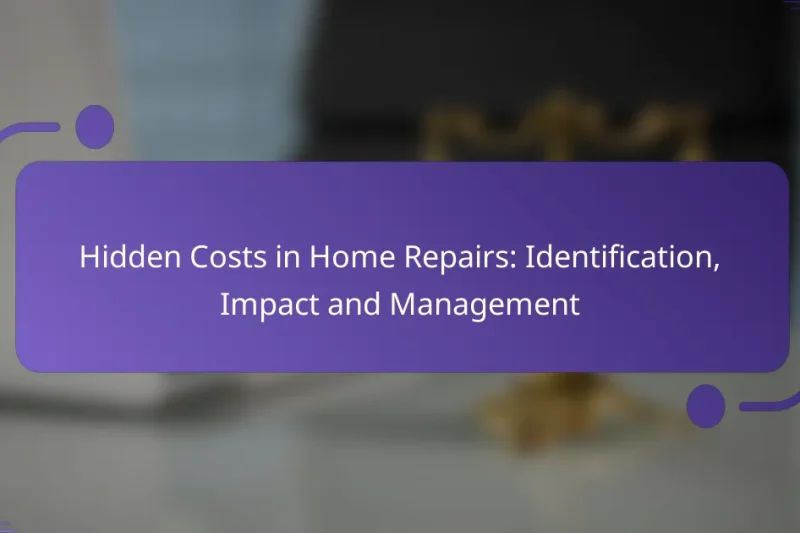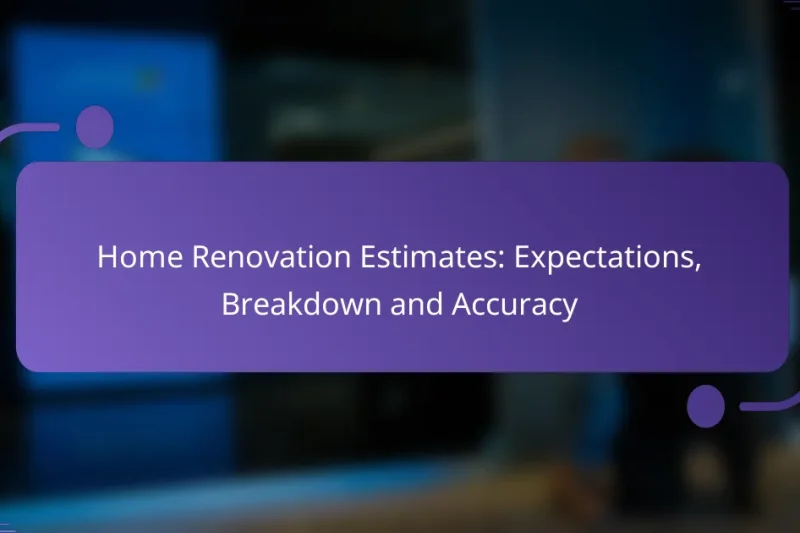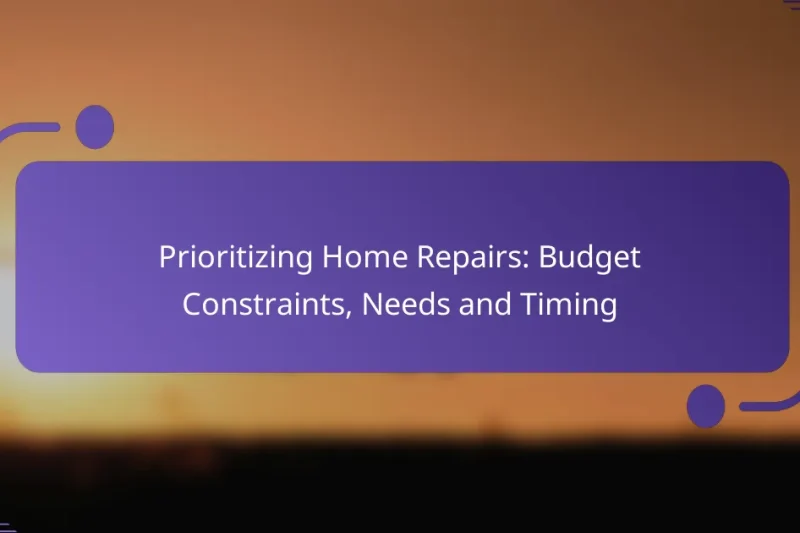Hidden costs in home repairs can lead to unexpected financial burdens, often causing the final bill … Hidden Costs in Home Repairs: Identification, Impact and ManagementRead more
Home Repair Services: Cost Estimates and Budgeting
Home repair services can range widely in cost, influenced by factors such as location, labor rates, and the complexity of the repairs needed. To effectively manage expenses, homeowners should create a detailed budget that accounts for both expected and unexpected repairs. By understanding the various elements that affect repair costs, you can better prepare for financial commitments and ensure your home remains in good condition.
Home Repair Budgeting: Realistic Planning, Cost Tracking and Savings
Creating a realistic home repair budget is essential for managing expenses and avoiding financial strain. By … Home Repair Budgeting: Realistic Planning, Cost Tracking and SavingsRead more
Home Repair Financing: Options, Benefits and Considerations
Home repair financing provides various options such as personal loans, home equity loans, and government grants, … Home Repair Financing: Options, Benefits and ConsiderationsRead more
Cost-Effective Home Repairs: Solutions, Comparisons and Budgeting
Cost-effective home repairs are essential for maintaining your property without overspending. By exploring DIY methods and … Cost-Effective Home Repairs: Solutions, Comparisons and BudgetingRead more
Home Renovation Estimates: Expectations, Breakdown and Accuracy
When planning a home renovation, understanding the estimates is crucial for budgeting effectively. These estimates can … Home Renovation Estimates: Expectations, Breakdown and AccuracyRead more
Prioritizing Home Repairs: Budget Constraints, Needs and Timing
Prioritizing home repairs is essential for maintaining safety and functionality, especially when budget constraints are a … Prioritizing Home Repairs: Budget Constraints, Needs and TimingRead more
Home Repair Quotes: Accuracy, Comparison and Contractor Selection
Obtaining accurate home repair quotes is essential for homeowners looking to manage costs effectively. By providing … Home Repair Quotes: Accuracy, Comparison and Contractor SelectionRead more
What are the average costs for home repair services in major US cities?
The average costs for home repair services can vary significantly across major US cities, typically ranging from a few hundred to several thousand dollars depending on the type of repair. Factors such as labor rates, material costs, and the complexity of the job all contribute to these variations.
Cost breakdown for plumbing repairs
Plumbing repairs often range from $150 to $500 for minor issues like leaky faucets or clogged drains. More extensive repairs, such as replacing pipes or fixing sewer lines, can cost between $1,000 and $3,000. It’s crucial to get multiple quotes and consider the plumber’s experience and reputation.
Common plumbing services include drain cleaning, pipe repairs, and water heater installation. Always check for licensing and insurance to ensure quality work and protection against potential damages.
Cost breakdown for electrical repairs
Electrical repairs generally cost between $100 and $500 for simple tasks like replacing outlets or switches. More complex jobs, such as rewiring or installing new circuits, can range from $1,000 to $3,500. Hiring a licensed electrician is essential for safety and compliance with local codes.
When planning electrical repairs, consider the age of your home and existing wiring. Older homes may require more extensive updates to meet current safety standards, which can increase costs.
Cost breakdown for roofing repairs
Roofing repairs can vary widely, with minor fixes costing around $200 to $1,000, while major repairs or replacements may range from $5,000 to $15,000. Factors influencing these costs include the type of roofing material, the extent of damage, and the roof’s pitch.
It’s advisable to get a thorough inspection before proceeding with repairs. Regular maintenance can help extend the life of your roof and prevent costly future repairs.
Cost breakdown for HVAC repairs
HVAC repairs typically range from $150 to $500 for minor issues like thermostat replacements or filter changes. More significant repairs, such as compressor replacements or ductwork repairs, can cost between $1,000 and $5,000. Regular maintenance can help avoid costly breakdowns and improve system efficiency.
When hiring an HVAC technician, ensure they are certified and familiar with local regulations. Seasonal maintenance checks can also help keep your system running smoothly and efficiently.
Cost breakdown for general handyman services
General handyman services usually charge between $50 and $150 per hour, depending on the complexity of the task and the handyman’s experience. Common jobs include painting, furniture assembly, and minor repairs. It’s wise to discuss the scope of work and get a written estimate before starting any project.
When hiring a handyman, look for reviews and recommendations. Clear communication about your expectations can help ensure satisfactory results and avoid misunderstandings regarding costs and timelines.
How to budget for home repair services?
Budgeting for home repair services involves estimating costs and allocating funds to cover necessary repairs. A well-structured budget helps homeowners manage expenses and prepare for unexpected issues effectively.
Creating a home repair budget plan
Start by assessing the condition of your home and identifying areas that need repair. Gather quotes from contractors or use online resources to estimate costs for various services, such as plumbing, roofing, or electrical work. This will give you a clearer picture of potential expenses.
Once you have estimates, create a detailed budget plan that includes both expected costs and a buffer for unforeseen expenses. A common recommendation is to set aside an additional 10-20% of your total repair budget for unexpected issues that may arise during the repair process.
Setting aside emergency funds
Establishing an emergency fund is crucial for managing home repairs. Aim to save at least three to six months’ worth of living expenses, which can help cover urgent repairs without disrupting your financial stability. This fund should be separate from your regular savings to ensure it’s available when needed.
Consider setting up automatic transfers to your emergency fund to make saving easier. Even small, regular contributions can accumulate over time, providing a safety net for unexpected home repair costs.
Prioritizing repairs based on urgency
Not all repairs are created equal; some require immediate attention while others can wait. Assess the urgency of each repair by considering factors such as safety, potential damage, and impact on daily living. For example, a leaking roof should be prioritized over cosmetic issues like peeling paint.
Create a list of repairs ranked by urgency and allocate your budget accordingly. Focus on critical repairs first, and once those are addressed, you can allocate funds for less urgent projects. This approach ensures that your home remains safe and functional while managing costs effectively.
What factors influence home repair costs?
Home repair costs can vary significantly based on several key factors. Understanding these elements helps homeowners budget effectively and avoid unexpected expenses.
Type of repair needed
The type of repair required plays a crucial role in determining costs. Simple tasks like patching drywall or replacing a faucet typically cost less than extensive projects such as roof replacement or foundation repairs. For example, minor plumbing repairs may range from $100 to $500, while major repairs can exceed $5,000.
Homeowners should prioritize repairs based on urgency and potential impact on the property. Addressing issues like water leaks immediately can prevent more costly damage later.
Location and accessibility
The location of the repair within the home can affect labor costs. Repairs in hard-to-reach areas, such as attics or crawl spaces, may require additional time and effort, leading to higher charges. For instance, accessing plumbing in a basement might be simpler than reaching it in a cramped attic.
Additionally, geographic location influences pricing. Urban areas often have higher labor rates compared to rural regions. Homeowners should obtain multiple quotes to gauge local pricing trends.
Materials and labor costs
The choice of materials significantly impacts overall repair costs. High-quality materials may have a higher upfront cost but can offer better durability and lower maintenance in the long run. For example, using premium roofing materials may cost more initially but could save money on repairs over time.
Labor costs also vary based on the complexity of the repair and the expertise required. Hiring licensed professionals may incur higher fees, but it ensures compliance with local building codes and standards. Homeowners should weigh the benefits of professional help against DIY options, especially for complex repairs.
How to choose a home repair service provider?
Choosing a home repair service provider involves evaluating their qualifications, reputation, and pricing. Focus on finding a contractor who meets your specific needs while providing reliable service at a fair cost.
Checking credentials and licenses
Verify that the home repair service provider holds the necessary licenses and certifications required in your area. This may include general contractor licenses, insurance, and bonding, which protect you from liability in case of accidents or damages.
In the United States, for example, many states require contractors to have specific licenses for electrical, plumbing, or HVAC work. Always ask for proof of these credentials before hiring a provider.
Reading customer reviews
Customer reviews offer valuable insights into a provider’s reliability and quality of work. Look for feedback on platforms like Google, Yelp, or Angie’s List to gauge the experiences of previous clients.
Pay attention to both positive and negative reviews, as they can highlight strengths and weaknesses. A provider with consistently high ratings and detailed feedback is often a safer choice.
Comparing quotes from multiple providers
Obtaining quotes from several home repair service providers is essential for making an informed decision. This allows you to compare pricing, services offered, and timelines to find the best fit for your project.
When comparing quotes, ensure that each estimate includes a detailed breakdown of costs, including labor, materials, and any potential additional fees. This transparency helps you avoid unexpected expenses later on.
What are common home repair scams to avoid?
Home repair scams often involve contractors who overpromise and underdeliver, leaving homeowners with incomplete or shoddy work. Being aware of these scams can help you protect your investment and ensure quality repairs.
Signs of a fraudulent contractor
Fraudulent contractors often exhibit certain red flags. They may demand large upfront payments, lack a physical business address, or pressure you into making quick decisions. Additionally, if they provide vague estimates or refuse to put agreements in writing, these are strong indicators of potential scams.
Another warning sign is if the contractor has a poor online reputation, such as numerous negative reviews or a lack of professional affiliations. Always be cautious if they offer unusually low prices compared to other estimates, as this can indicate subpar materials or workmanship.
How to verify contractor legitimacy
To verify a contractor’s legitimacy, start by checking their licensing and insurance status. Most states require contractors to be licensed, and you can often verify this through your local regulatory agency. Ensure they carry liability insurance and workers’ compensation to protect yourself from potential liabilities.
Request references from previous clients and follow up with them to inquire about their experiences. Additionally, consult online review platforms and check for any complaints filed with the Better Business Bureau. A reputable contractor should be transparent and willing to provide this information without hesitation.
What are the benefits of regular home maintenance?
Regular home maintenance offers numerous advantages, including enhanced property value and improved safety. By addressing minor issues early, homeowners can prevent larger, more expensive repairs down the line.
Preventing costly repairs
Preventing costly repairs is one of the primary benefits of regular home maintenance. Routine inspections and upkeep can identify potential problems, such as leaks or electrical issues, before they escalate into major expenses. For example, a small roof leak can lead to significant water damage if not addressed promptly.
Homeowners should create a maintenance schedule that includes seasonal checks for critical systems like plumbing, HVAC, and roofing. This proactive approach can save thousands of dollars over time, as it is generally much cheaper to fix minor issues than to wait for them to become serious problems.
Common maintenance tasks include cleaning gutters, checking for signs of pests, and inspecting appliances for wear. Setting aside a budget of a few hundred dollars annually for these tasks can significantly reduce the risk of unexpected repair costs.





